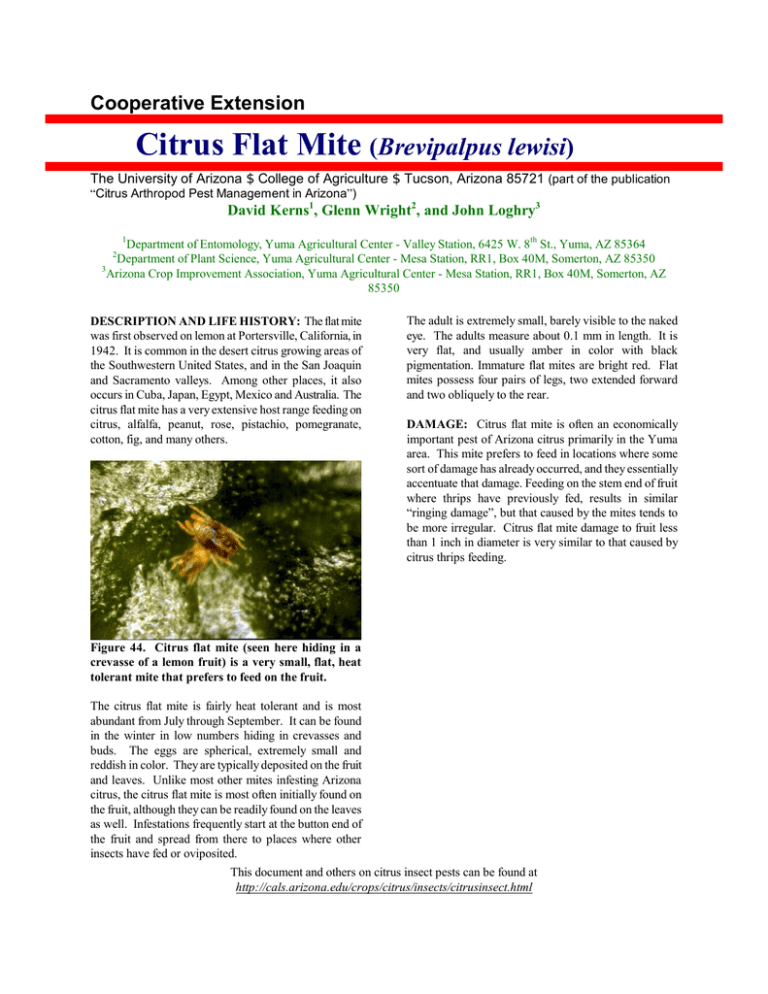Citrus Flat Mite Brevipalpus lewisi Cooperative Extension
advertisement

Cooperative Extension Citrus Flat Mite (Brevipalpus lewisi) The University of Arizona $ College of Agriculture $ Tucson, Arizona 85721 (part of the publication “Citrus Arthropod Pest Management in Arizona”) David Kerns1, Glenn Wright2, and John Loghry3 1 Department of Entomology, Yuma Agricultural Center - Valley Station, 6425 W. 8th St., Yuma, AZ 85364 Department of Plant Science, Yuma Agricultural Center - Mesa Station, RR1, Box 40M, Somerton, AZ 85350 3 Arizona Crop Improvement Association, Yuma Agricultural Center - Mesa Station, RR1, Box 40M, Somerton, AZ 85350 2 DESCRIPTION AND LIFE HISTORY: The flat mite was first observed on lemon at Portersville, California, in 1942. It is common in the desert citrus growing areas of the Southwestern United States, and in the San Joaquin and Sacramento valleys. Among other places, it also occurs in Cuba, Japan, Egypt, Mexico and Australia. The citrus flat mite has a very extensive host range feeding on citrus, alfalfa, peanut, rose, pistachio, pomegranate, cotton, fig, and many others. The adult is extremely small, barely visible to the naked eye. The adults measure about 0.1 mm in length. It is very flat, and usually amber in color with black pigmentation. Immature flat mites are bright red. Flat mites possess four pairs of legs, two extended forward and two obliquely to the rear. DAMAGE: Citrus flat mite is often an economically important pest of Arizona citrus primarily in the Yuma area. This mite prefers to feed in locations where some sort of damage has already occurred, and they essentially accentuate that damage. Feeding on the stem end of fruit where thrips have previously fed, results in similar “ringing damage”, but that caused by the mites tends to be more irregular. Citrus flat mite damage to fruit less than 1 inch in diameter is very similar to that caused by citrus thrips feeding. Figure 44. Citrus flat mite (seen here hiding in a crevasse of a lemon fruit) is a very small, flat, heat tolerant mite that prefers to feed on the fruit. The citrus flat mite is fairly heat tolerant and is most abundant from July through September. It can be found in the winter in low numbers hiding in crevasses and buds. The eggs are spherical, extremely small and reddish in color. They are typically deposited on the fruit and leaves. Unlike most other mites infesting Arizona citrus, the citrus flat mite is most often initially found on the fruit, although they can be readily found on the leaves as well. Infestations frequently start at the button end of the fruit and spread from there to places where other insects have fed or oviposited. This document and others on citrus insect pests can be found at http://cals.arizona.edu/crops/citrus/insects/citrusinsect.html hand lens. Particular attention should be paid to the button area of the fruit. Currently there is no action threshold for citrus flat mite but some general guidelines exist. Miticides may been necessary to control citrus flat mites on the fruit when 10% of the fruit less than 1 inch in diameter is infested, when fruit 1 to 2 inches in diameter average 3 to 5 mites per fruit, or when fruit greater than 2 inches in diameter average 20 mites per fruit. CONTROLS: Cultural: There are no common cultural practices designed specifically to impact citrus flat mite. Biological: •Predators. A number of predators that attack Citrus flat mites including predatory mites, lacewings, predacious thrips, etc. Commonly used Chemicals: Citrus flat mites are fairly easy to control using miticides, and are especially sensitive to sulfur (see below for chemical control section for all mites). Figure 45. (Top) Lemon on left completely silvered from extensive feeding by citrus flat mite, relative to normal lemon on right; (Bottom) citrus flat mite scarring usually begins where citrus thrips have previously fed, but spreads the scarring in an irregular pattern. Scarring starts out silvery in color, but becomes brown and corky with age, or after fumigation for coloring. When the mite population is high, the entire fruit surface may become silvered. Feeding damage by this mite on fruit 1 to 2 inches in diameter causes a brownish, corky and scab like appearance, sometimes referred to as russetting, while damage to larger fruit will appear similar, but may not be evident until the fruit has been fumigated for coloring. The flat mite and related species are known vectors of citrus leprosis virus which can be extremely damaging. This virus causes large chlorotic blothes on the fruit, leaves and stems of citrus. Leprosis virus is currently in Florida, South and Central America, and possibly southern Mexico. MONITORING: Citrus should be monitored for citrus flat mite spider mite beginning at petal fall though September. Fruit should be inspected closely with a 10X This document and others on citrus insect pests can be found at http://cals.arizona.edu/crops/citrus/insects/citrusinsect.html




